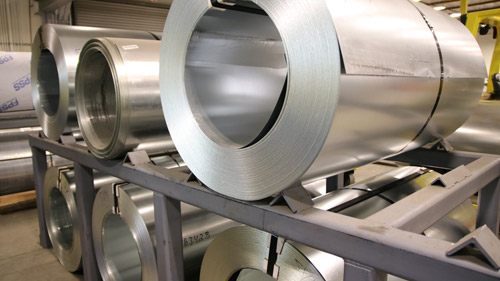When it comes to election predictions, while the winning candidate is still up in the air, steel will win regardless.
That was the takeaway when Cleveland-based Majestic Steel briefed the Spiral Duct Manufacturers Association on the state of the steel market at their annual meeting in Charleston, South Carolina in April.
Having recently expanded with a new facility in Hickman, Arkansas, speaker and Vice President of commercial sales Kevin Ginley says the company is positioning itself to capitalize on a strong backdrop for the economy.
Ginley shared how economists broadly anticipate large, steel-consuming developments will continue their upwards growth trajectory in 2025.
“Hotels are going to jump from a 4% growth rate to 17% in 2025. A lot of economists are talking about ’25 being a boom year. Meaning, get through ’24, get through this election year, see who’s in, and then either play by the same rules, or by different rules,” Ginley said.
Made in America
Both President Joe Biden and former President Donald Trump have vowed to thwart the acquisition of U.S. Steel by Nippon Steel and to protect the U.S. steel industry with tariffs on Chinese steel.
“We do bring some foreign steel in, because that's the easiest way to get steel to Houston, to Tampa, to LA for example. You have to play the play the game there,” Ginley said, noting America doesn’t have the mill capacity to cover all domestic demand and needs global trade. “The rest of our plants are all domestic. Structurally there's no difference, but it’s going to say it’s G-90.”
Made in USA, “versus made and melted in USA, are two different things,” Ginley added; noting that with the Build America, Buy America Act, steel produced in Mexico and Canada count as “American made.” State laws like Buy American in Texas require U.S. origin, unless the supplier’s price is 20% higher than a foreign source.
“There’s a hospital network in Texas and every time they're building a new hospital, it has to have the mill stencil on it. You can't be just be generic. It has to have the name of the mill on there,” Ginley added.
Keeping pace
Sheet metal shops are keeping pace with increased demand from federally leveraged investments in semiconductor and EV manufacturing plants. But the size and scope of these projects is driving shops like Ventcon to scale up massively, building new sheet metal shops around the country ahead of manufacturing plant development.
“Some of these places are so big that one of our customers actually took their spiral line and put it on the floor on the job site at this big battery plant that's being built. There's going to be over 400,000 pounds of duct made in a short period of time and they brought it right to the site,” Ginley said. “I haven't seen a lot of that before. I'm sure it's happened, but maybe it’ll be a new trend.”
On the subject of government spending, and how a new administration could potentially derail spending commitments of the Biden administration, Ginley said the possibilities are there and throw volatility into the market.
“But there's still a lot of government spending that was approved and it has to go up. There's a lot of projects out there that we haven’t really dove into yet,” Ginley said, adding these projects are smoothing out demand as construction has entered into a stalling, slow-growth pattern. “We're anticipating some of that will help us through the second half of this year.”
 (STAFF PHOTO)
(STAFF PHOTO)Lead times and steel prices
The reduction of 24 steel mills in the U.S. in 1999, to four in 2024 increases price volatility, Ginley said, with mills now hitting high lead times chronically in the winter, causing price spikes to stick for longer. Spot steel was sold out by September of last year, causing prices to increase by $100 ton increments four times in a row.
Prices remain elevated, with Majestic Steel tracking rolled steel prices to go up slightly in June compared to May, although Ginley noted there’s no drastic change in lead times, the leading indicator for sticky price increases.
“Service centers have had leaner inventories, just to make sure they're playing in that market and not getting stuck with too much steel on the floor they can't sell, or not enough and then they're scrambling and paying a higher spot price,” Ginley concluded. “And that’s what’s causing those mills to keep those prices up.”



Report Abusive Comment